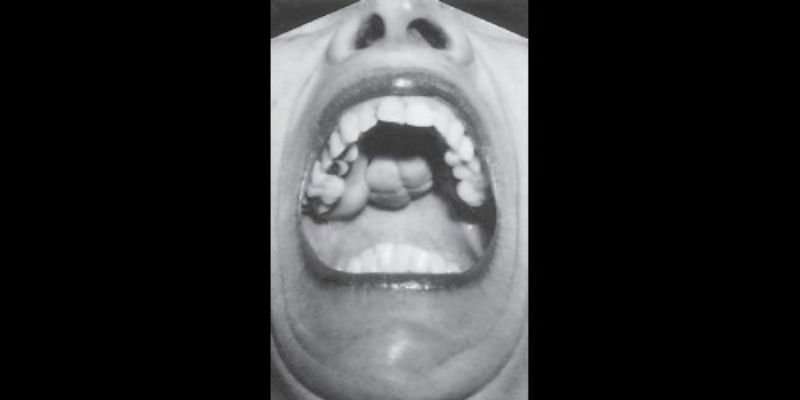In 1994, an athletic man we'll call John was involved in a car crash. He was uninjured, and X-rays of his spine showed no fractures. They did, however, reveal unusually dense bones. John's radiologist referred him to Karl Insogna, the director of the Yale Bone Center. "His bone density was eight times higher than average for a man his age," Insogna recalls. This fact may not have surprised John, who used to sink like a stone when he tried to swim. Unable to determine a diagnosis or any negative symptoms, Insogna sent John on his way.
Six years later, Insogna heard a fellow physician mention he'd seen a family with very high bone mass. Together they traced the family tree, linking John to an extended kin group sprinkled up and down the Eastern seaboard. The affected kin all had very dense bones and unusually square jaws, but otherwise normal skeletons. One of the affected family members is a physician in Alabama. "He's had several failed hip replacements because they can't screw the prosthesis into his bone," Insogna says. "It's too hard." Studying the family, Insogna's team zeroed in on a region of chromosome 11 likely linked to the unusual trait. But at the time, he says, the region was just too long to sequence.
How a car accident led to a genetic finding—and why the publication of the human genome helped.
Elsewhere, others were looking at chromosome 11 as well. A team led by Matthew Warman, of Case Western Reserve University, found a gene mutation called LRP5. (It codes for LDL receptor-related protein 5.) They'd linked the mutation to low bone density. Insogna's team wondered if the gene could cause abnormally high density as well. "We decided we should look at that gene, and low and behold, there was a mutation," he says.
As it turned out, Mark Johnson and his colleagues at the Osteoporosis Research Center at Creighton University in Omaha had already zeroed in on exactly the same mutation while studying a Nebraska family with unusually dense bones. They'd identified 21 family members with the condition. "None of those people, ranging in age from 3 to 93, had ever had a broken bone," marvels Johnson, now at the University of Missouri-Kansas City.
Within a period of a few months, LRP5 became big news. Warman's team reported its findings in Cell in November 2001. 1 Two months later, Johnson's group published in the American Journal of Human Genetics, 2 and Insogna's study appeared in the New England Journal of Medicine in May that same year. 3
Johnson and his colleagues had been able to locate LRP5 in the genetic haystack before the complete human genome sequence was published, he said, because they'd partnered with Genome Therapeutics (now Oscient Pharmaceuticals), a company that was part of the public sequencing effort. "We had our findings within a year, at a time when that process would have taken me, working in my lab, 5 or 10 years," he says.
"After we published our initial findings, we started getting phone calls from clinical colleagues from around the country," Johnson recalls. They collected accounts of dozens of families. All that Johnson examined turned out to have some type of mutation on LRP5.
The scientists linked LRP5 to the Wnt signaling pathway, a family of molecules known to be important for growth and development. Now they realized that pathway was also critical for the regulation of bone mass—making it an obvious target for developing treatments for osteoporosis and other skeletal disorders. "In contrast to other bone mass mutations, this is gain in bone formation, not inhibition of bone breakdown," Insogna says. "In osteoporosis [research], that's the Holy Grail."
Suddenly, researchers around the globe began turning their attention to LRP5 in mice and men. "Those papers led to an explosion of interest in the Wnt signaling pathway," Insogna says. "Over the last four years there's been an avalanche of information."
These days, much of the legwork is done not in the lab but in front of the computer. "When [you] determine the region of the genome where a gene exists, you're able to go into a database and pull up a list of all the genes in that region," Johnson notes. "From a scientific perspective, that is one of the huge benefits we've gained from having the completed sequence."
Many questions about the Wnt pathway remain unanswered, but Insogna and Johnson are hopeful that clinical trials of osteoporosis treatments stemming from their work could begin within five years. "It's been an exciting 10 years in terms of research. It's great that so many people have jumped into this field," Johnson says. "I think we're just seeing the tip of the iceberg right now."

predictingzepast on July 22nd, 2018 at 21:54 UTC »
Maybe not swim, but that means they can walk underwater like a hippo..
icantfeelmyskull on July 22nd, 2018 at 21:46 UTC »
Sucks if they have no choice but to hack their own leg off in order to survive a rock climbing accident that left them stuck in a chasm
MrVierPner on July 22nd, 2018 at 21:07 UTC »
Sounds like a fallout perk